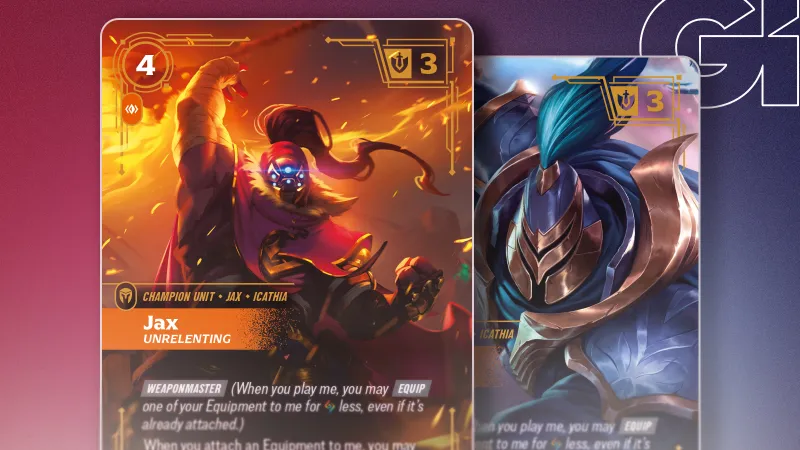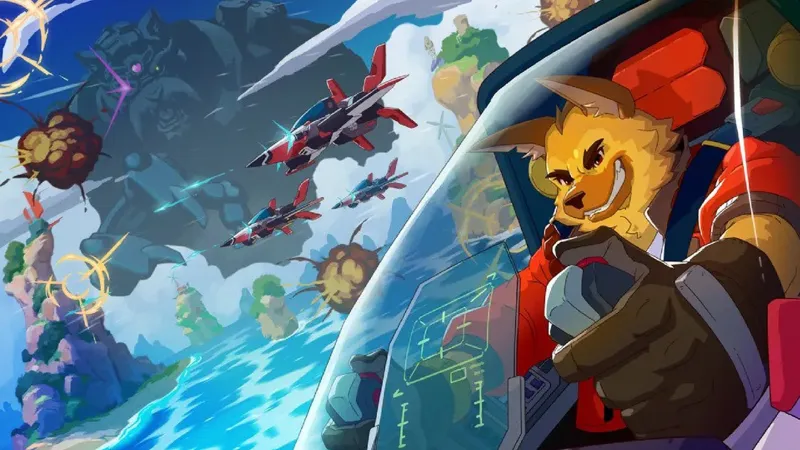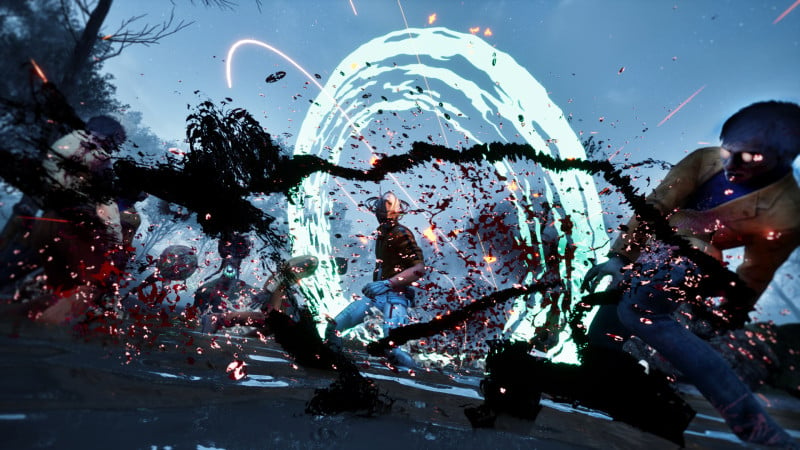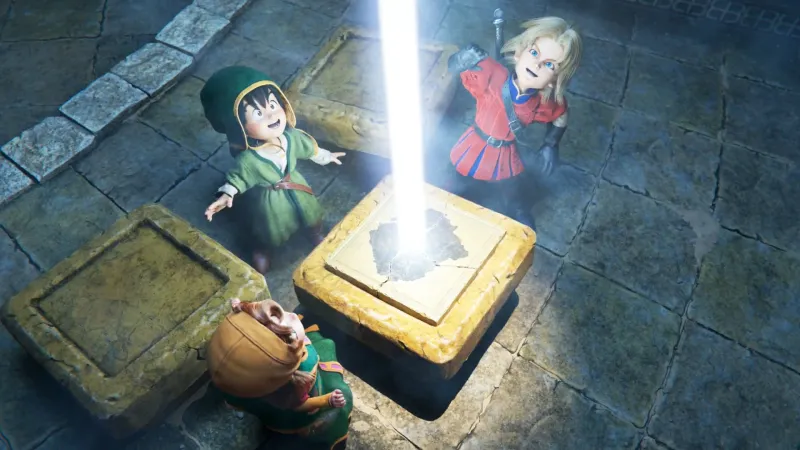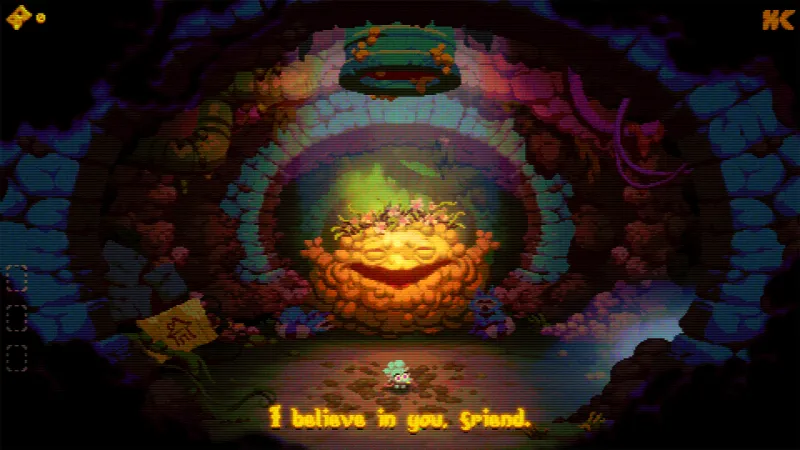During Gamescom 2025 last week in Cologne, Germany, I went hands-on with No More Heroes developer Grasshopper Manufacture’s upcoming action game, Romeo Is A Dead Man, and came away with more questions than answers (but in the best way possible). Fortunately, I immediately transitioned from my hands-on preview to a couch, where I sat across from the game’s director, Goichi Suda AKA Suda51, and his interpreter, and asked him the new questions I had.
But first, let me set the scene of my demo: before gameplay began, I watched a quick intro you’ve likely seen in the game’s reveal trailer that shows Romeo die, then be resurrected and turned into a space cop/FBI agent/expert mercenary/cyborg hybrid. From here, I was brought to a screen with three impeccably designed chocolates. I forgot the name of the first chocolate (and unfortunately didn’t write it down), but it represented the game’s easy mode; the orange chocolate I chose represented normal, and the ginger-infused chocolate was the game’s hard mode. I was then thrust right into the action.
I’m not quite sure where I was, but it was reminiscent of a junk yard; gray, foggy, and swarmed with zombies and other monstrous creatures Romeo needed to kill. Doing so was a blast, thanks to a combat system that feels fast, fluid, and visceral, with a large selection of weaponry to use. I used a machine gun, a pistol, a grasshopper-shaped rocket launcher, and a fusion rifle, of sorts, as well as a katana-like sword, a colossal two-handed sword, and more. All of them are easily accessible with a combo of buttons tied to the d-pad. I like that each gun has a different feel, and that each melee weapon features its own moveset, all in the name of dismembering and beheading hordes of zombies and everything else that stands in the way of Romeo.
Romeo Is A Dead Man was, by far, the bloodiest demo I saw during Gamescom, and I previewed more than two dozen games, including Resident Evil Requiem. Despite the gallons and gallons of blood, though, it comes off comedically rather than horrifically, thanks to the game’s visual flair.
After I mowed down enough enemies in this junkyard-like area, I warped into cyberspace, another visually distinct part of the game with its own narrative ties. There was a boss at the end of this area, but I wasn’t able to reach it as my time to interview Suda51 had arrived. Before diving into what I learned from my interview, I’ll close out my preview thoughts here by saying I continue to grow increasingly intrigued by what the hell Romeo Is A Dead Man is doing each time I see and play it. It’s hard to explain what this game is, but that’s part of its charm, and I can’t wait to find out how all its seemingly disparate pieces connect when it launches next year.
Discussing Romeo Is A Dead Man And Grasshopper Manufacture With Suda51
Game Informer’s Wesley LeBlanc: There is a lot going on in Romeo Is A Dead Man, but from a broad approach, what are the inspirations behind the game?
Suda51: You may have noticed playing a bit of the game, but a few of the main influences and inspirations for the game are Back to the Future and Rick and Morty, which itself was inspired by Back to the Future. We wanted to do something with space time and time travel, and the whole thing started off with looking to those two properties.
There are so many distinct art styles in Romeo Is A Dead Man. What are some of the inspirations behind that?
As far as the art and visual style go, that aspect of the game didn’t have much to do with the [Back to the Future and Rick and Morty] influences. Where that came from was basically, I wanted to make sure all the staff members working on the game were able to do their best and what they’re best at.
For the art, if we have one staff member good at Western-style comic book art, I’d say, “I want you to draw this scene, it’d look really great with your style.” Somebody else is really good at a different style, and I would think of a scene for that person in particular to work on. It was about finding a proper rhythm for each scene, matching the content of the scene and what the characters are doing, and how it could be portrayed best.
I try to match up all the members of the staff to a scene, let them do the best at what they do, and jamming it all together.
That’s a very different director approach from what I hear about studios in the West. What’s your philosophy behind that directorial style and letting people do things in their own vision?
It’s pretty simple, really. As far as my philosophy goes, I want it to be fun. We want to make fun games that people like playing, and we want everything about game development to be fun, too. In game development, there’s a lot of heavy s*** to deal with, hard times to deal with, so I wanted not just playing the game to be fun, but the development and creation of it to be as fun as possible, too.
I lay out my ideas in meetings, and we might have some planning, but I let people from any department talk, tweak versions of ideas, and create a collaborative process. Anyone can cross out ideas, combine something to make new ideas, or take separate ideas and turn them into different things. We try to make it as fun as possible, and I want everyone to have as much fun as they can creating the game. We want them to know their opinions are heard and respected.
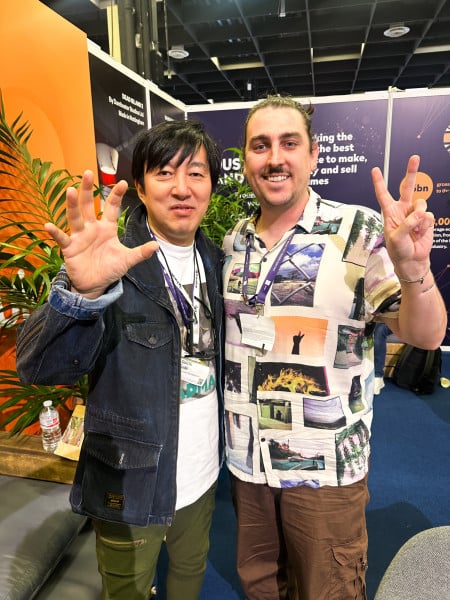
Romeo Is A Dead Man director Suda51 and editor Wesley LeBlanc at Gamescom 2025
How do you factor in game balance with that approach?
A lot of game developers don’t like thinking like this, because it might “ruin the balance of the game” if there are too many ideas. I don’t care about that personally; I want the game to be fun and interesting. As far as balance goes, I’ll take care of that in the end. If you have a good idea, let everybody know, and in the end, I’ll make sure everything is as balanced as possible.
I think the team we’ve put together, they trust me to take care of that balance, which is why they feel free to put out different ideas they have. They can trust in me. Balance is probably one of the things I’m best at as a game developer – taking all these ideas that might not seem related, and balancing them.
Can you talk to me about the process behind the game’s combat design?
As far as the combat goes, that was actually mainly up to one of our lead programmers, Toru Hironaka, who has been at Grasshopper for years. I kind of left the combat and general action up to him because I know he knows what he’s doing.
From the beginning, I knew there were going to be gun-type weapons and sword-type weapons, and I wanted to make both appealing. I knew we had to make them fun to use and as interesting as any other weapon, so I talked with Hironaka and said, ‘These are the systems and action I want, do what you do best.” I had other staff members give input, too.
As far as the action stuff goes, it’s mainly Hironaka leading, but as a whole, [Romeo Is A Dead Man] came together the way it did through the power of teamwork. It’s never just one guy doing everything by himself.

The time between your last release and Romeo Is A Dead Man [due out in 2026] is the longest in development history at Grasshopper Manufacture. Why?
The main reason it took so long is timing, basically. For example, right around when we started on Romeo Is A Dead Man, it was right about the time we left GungHo Entertainment and joined NetEase, and we increased staff members, and it took them time to get used to how we do things and vice versa. Also, up through No More Heroes III, we worked on Unreal Engine 4, but Romeo Is A Dead Man is being developed in Unreal Engine 5, so our first year developing [Romeo Is A Dead Man], it was people learning Unreal Engine 5, learning how to work with each other, learning how the company works, and everyone getting used to each other and everything.
That’s the biggest reason it took so long. It’s not necessarily that the game is huge, and it wasn’t the worst possible timing; everything just happened at the point in time that would result in us taking the most time to get the game done.
Romeo Is A Dead Man launches sometime next year on PlayStation 5, Xbox Series X/S, and PC.

